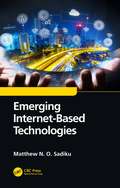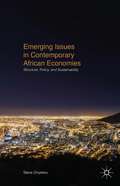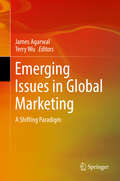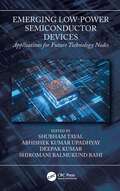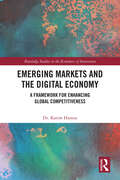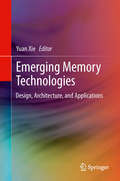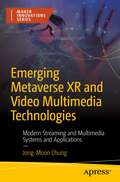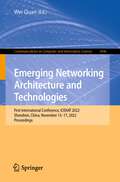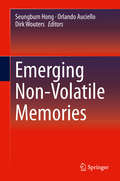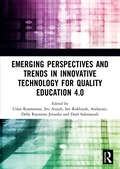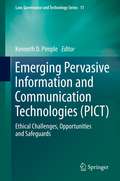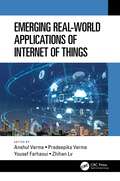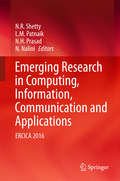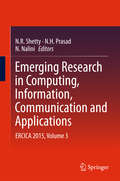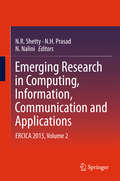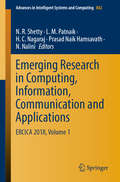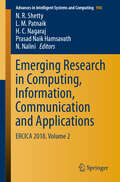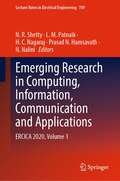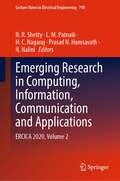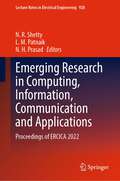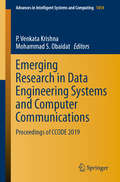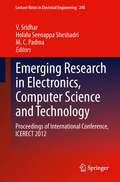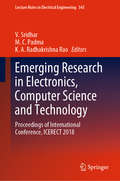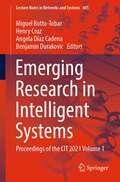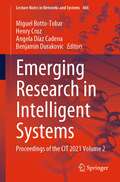- Table View
- List View
Emerging Internet-Based Technologies
by Matthew N. SadikuThe author of this book has identified the seven key emerging Internet-related technologies: Internet of things, smart everything, big data, cloud computing, cybersecurity, software-defined networking, and online education. Together these technologies are transformational and disruptive. This book provides researchers, students, and professionals a comprehensive introduction, applications, benefits, and challenges for each technology. It presents the impact of these cutting-edge technologies on our global economy and its future. The word "technology" refers to "collection of techniques, skills, methods, and processes used in the production of goods or services."
Emerging Issues In Contemporary African Economies
by Steve OnyeiwuIn Emerging Issues in Contemporary African Economies, Onyeiwu focuses on how events of the twenty-first century are shaping key sectors of African economies and societies. He argues that while there have been significant improvements in African economies, major challenges still remain. Onyeiwu implicitly adopts an evolutionary methodology that recognizes the capacities of African countries to learn from past policy mistakes, experiment with new policy initiatives, and adapt to evolvingeconomic challenges and opportunities. This great contribution to the literature explores new themes that have become central to the sustainable performance of African economies: the IT revolution, industrial dynamics, innovation and technological change, youth and gender, as well as issues around structural transformation.
Emerging Issues in Global Marketing: A Shifting Paradigm
by Terry Wu James AgarwalThis book examines emerging theories, frameworks, and applications of global marketing for the 21st century. It highlights how global marketing is changing in a globalized and digital economy that is fast increasing in complexity and uncertainty. The traditional approach to global marketing is no longer sufficient to address the emerging issues in global markets. Global companies need to challenge traditional assumptions in global marketing in an era of shifting political, cultural, economic, and technological changes. They need to take a fresh look at the contemporary threats and opportunities in markets, institutions, and technology and how they affect entry and expansion strategies through careful re-calibration of the marketing-mix. This book offers new insights for global marketing that addresses these issues. This book should be an ideal resource to both academic scholars and reflective practitioners globally such as CEOs and chief marketing officers as well as government officials and policy makers interested in formulating strategies/policies for global marketing activities in the face of a globalized and digitized economy. This well-crafted research volume is an excellent addition to the growing literature on new trends in international marketing. The authors present the latest insight on the impact of phenomena such as cross-border e-commerce and digital markets, and they discuss new tools for political risk assessment, international branding and more broadly the reconfiguring of marketing-mix strategies – A powerful reminder that the new global market remains a rugged landscape. - Alain Verbeke, McCaig Research Chair in Management and Editor-in-Chief Journal of International Business Studies, University of Calgary, Canada. Emerging trends in institutions, markets, and societies, along with new technological advances, are redefining the scope and strategy in global marketing. Professors Agarwal and Wu have assembled a remarkable collection of cutting-edge topics and issues that capture the shifting paradigm and contemporary developments in the global marketing field. This is an informative and timely resource that makes a valuable contribution, useful for both scholars and business practitioners of global marketing. - Constantine S. Katsikeas, Arnold Ziff Endowed Research Chair in Marketing & International Management, Editor-in-Chief Journal of International Marketing, University of Leeds, UK. This book presents new and cutting-edge thinking at a time when the traditional views of international marketing need to be scrapped. Convergence forces are creating new opportunities as well as threats on a daily basis, and marketing practitioners as well as scholars must be forewarned as well as forearmed on how to deal with these changes. The real growth is coming from the emerging nations, and the theories that provided sufficient insights ten years ago have been completely outmoded by the ever-accelerating rate of innovation and technological change as well as the pressures to address the needs of all of the firm’s relevant stakeholders. The strategic insights provided here are absolutely invaluable. Don’t miss an opportunity to read this book!! - John B. Ford, Professor of Marketing & International Business, Eminent Scholar & Haislip-Rohrer Fellow, Editor-in-Chief, Journal of Advertising Research, Old Dominion University, USA.
Emerging Low-Power Semiconductor Devices: Applications for Future Technology Nodes
by Shubham TayalThis book gives insight into the emerging semiconductor devices from their applications in electronic circuits. It discusses the challenges in the field of engineering and applications of advanced low-power devices. Emerging Low-Power Semiconductor Devices: Applications for Future Technology Nodes offers essential exposure to low-power devices, and applications in wireless, biosensing, and circuit domains. This book provides a detailed discussion on all aspects, including the current and future scenarios related to the low-power device. The book also presents basic knowledge about field-effect transistor (FET) devices and introduces emerging and novel FET devices. The chapters include a review of the usage of FET devices in various domains like biosensing, wireless, and cryogenics applications. The chapters also explore device-circuit co-design issues in the digital and analog domains. The content is presented in an easy-to-follow manner that makes it ideal for individuals new to the subject. This book is intended for scientists, researchers, and postgraduate students looking for an understanding of device physics, circuits, and systems.
Emerging Markets and the Digital Economy: A Framework for Enhancing Global Competitiveness (Routledge Studies in the Economics of Innovation)
by Karim HamzaThis book provides a strategic blueprint for understanding how pioneering emerging markets are leveraging the digital economy to challenge global economic hierarchies. It explores the role of disruptive technologies like AI, 5G, and fintech in reshaping industries, markets, and economic structures.Designed for researchers, business leaders, policymakers, and strategists, this book delivers a comprehensive analysis of how countries such as China, India, South Korea, Saudi Arabia, the UAE, Turkey, Malaysia, Vietnam, Mexico, and Egypt are driving digital competitiveness. Through in-depth case studies and a data-driven approach, readers will gain valuable insights into the policies, investments, and innovations that have propelled these economies onto the global stage.By uncovering the strategies behind digital success, this playbook equips readers with the knowledge and tools to navigate the evolving global economy, seize emerging opportunities, and anticipate the next wave of digital disruption.
Emerging Memory Technologies
by Yuan XieThis book explores the design implications of emerging, non-volatile memory (NVM) technologies on future computer memory hierarchy architecture designs. Since NVM technologies combine the speed of SRAM, the density of DRAM, and the non-volatility of Flash memory, they are very attractive as the basis for future universal memories. This book provides a holistic perspective on the topic, covering modeling, design, architecture and applications. The practical information included in this book will enable designers to exploit emerging memory technologies to improve significantly the performance/power/reliability of future, mainstream integrated circuits.
Emerging Metaverse XR and Video Multimedia Technologies: Modern Streaming and Multimedia Systems and Applications
by Jong-Moon ChungImprove the video multimedia services you work on or develop using tools from video service technologies such as Netflix, Disney+, YouTube, and Skype. This book introduces you to the core technologies that enable Metaverse XR (eXtended Reality) services and advanced video multimedia streaming services.First, you’ll find out about the current and future trends in Metaverse and video streaming services. XR is a combination of technologies that include MR, AR, VR, voice recognition systems, haptic and 3D-motion UIs, as well as head mounted displays) like Microsoft Hololens 2 and Oculus Quest 2. You'll review metaverse services XR applications and learn more about the core XR feature extraction technologies. With XR capabilities mastered, you can move into the main technologies for video streaming services like Netflix, Disney+, and YouTube. You’ll also about video formats, such as H.264, MPEG-4 AVC, H.265, MPEG-5, and MPEG-DASH. As well as online hosting services like content delivery network (CDN), mobile CDN, and Amazon Web Services (AWS). Additional details on content aging and updating operations along with CDN popularity predictions and contents update techniques, such as, Least Recently Used (LRU) and east Frequently Used (LFU) strategies are introduced. All these technologies enable fast, efficient, reliable, and adaptable video streaming services. They also allow for video conferencing services like Zoom, Skype and WebEx. By the time you’ve finished reading, you’ll understand how these technologies converge into the Metaverse and and offer a wide variety of development opportunities for video streaming. What You'll LearnIncorporate core AI techniques and extraction XR algorithmsEnable fast, efficient, and reliable video streaming in your product, service, or appUpdate content with CDN popularity predictionsExplore the Netflix Open Connect CDN model and characteristics Understand the operations of modern video and multimedia systemsBecome a leader in metaverse and video multimedia services and products.Who This Book Is ForDevelopers, product managers, hobbyists, and students interested in learning how Metaverse XR and video streaming work and can be developed.
Emerging Networking Architecture and Technologies: First International Conference, ICENAT 2022, Shenzhen, China, November 15–17, 2022, Proceedings (Communications in Computer and Information Science #1696)
by Wei QuanThis book constitutes refereed proceedings of the First International Conference on Emerging Networking Architecture and Technologies, ICENAT 2022, held in Shenzhen, China, in October 2022.The 50 papers presented were thoroughly reviewed and selected from the 106 submissions. The volume focuses on the latest achievements in the field of emerging network technologies, covering the topics of emerging networking architecture, network frontier technologies, industry network applications and so on.
Emerging Non-Volatile Memories
by Seungbum Hong Orlando Auciello Dirk WoutersThis book is an introduction to the fundamentals of emerging non-volatile memories and provides an overview of future trends in the field. Readers will find coverage of seven important memory technologies, including Ferroelectric Random Access Memory (FeRAM), Ferromagnetic RAM (FMRAM), Multiferroic RAM (MFRAM), Phase-Change Memories (PCM), Oxide-based Resistive RAM (RRAM), Probe Storage, and Polymer Memories. Chapters are structured to reflect diffusions and clashes between different topics. Emerging Non-Volatile Memories is an ideal book for graduate students, faculty, and professionals working in the area of non-volatile memory. This book also: Covers key memory technologies, including Ferroelectric Random Access Memory (FeRAM), Ferromagnetic RAM (FMRAM), and Multiferroic RAM (MFRAM), among others. Provides an overview of non-volatile memory fundamentals. Broadens readers' understanding of future trends in non-volatile memories.
Emerging Perspectives and Trends in Innovative Technology for Quality Education 4.0: Proceedings of the 1st International Conference on Innovation in Education and Pedagogy (ICIEP 2019), October 5, 2019, Jakarta, Indonesia
by Siti Aisyah Isti Rokhiyah Andayani Della Raymena Jovanka Dodi Sukmayadi Udan KusmawanIndustrial Revolution 4.0 has dramatically changed the business and social landscape, including human behavior not only in advanced countries but also in emerging countries. Technology development affects many aspects in our society, including education. Distance learning, big data and analytics, artificial intelligent and many digital innovations have been released to improve better quality education in our society. These proceedings provide selected papers/research about innovative digital technology in education and pedagogy in Industrial revolution 4.0 covering issues like: pedagogy, education management, early childhood education, research in education, training and vocational education and social science education, earth science education and art/linguistic education related to digital innovation.This book provides details beyond what is possible to be included in an oral presentation and constitute a concise but timely medium for the dissemination of recent research results. It will be invaluable to professionals and academics in the field of education and pedagogy to get an understanding of recent research.
Emerging Pervasive Information and Communication Technologies (PICT): Ethical Challenges, Opportunities and Safeguards
by Kenneth D. PimpleThis book provides a wide and deep perspective on the ethical issues raised by pervasive information and communication technology (PICT) - small, powerful, and often inexpensive Internet-connected computing devices and systems. It describes complex and unfamiliar technologies and their implications, including the transformative potential of augmented reality, the power of location-linked information, and the uses of "big data," and explains potential threats, including privacy invaded, security violated, and independence compromised, often through widespread and lucrative manipulation. PICT is changing how we live, providing entertainment, useful tools, and life-saving systems. But the very smartphones that connect us to each other and to unlimited knowledge also provide a stream of data to systems that can be used for targeted advertising or police surveillance. Paradoxically, PICT expands our personal horizons while weaving a web that may ensnare whole communities. Chapters describe particular cases of PICT gone wrong, but also highlight its general utility. Every chapter includes ethical analysis and guidance, both specific and general. Topics are as focused as the Stuxnet worm and as broad as the innumerable ways new technologies are transforming medical care. Written for a broad audience and suitable for classes in emerging technologies, the book is an example of anticipatory ethics - "ethical analysis aimed at influencing the development of new technologies" (Deborah Johnson 2010). The growth of PICT is outpacing the development of regulations and laws to protect individuals, organizations, and nations from unintended harm and malicious havoc. This book alerts users to some of the hazards of PICT; encourages designers, developers, and merchants of PICT to take seriously their ethical responsibilities - if only to "do no harm" - before their products go public; and introduces citizens and policy makers to challenges and opportunities that must not be ignored.
Emerging Real-World Applications of Internet of Things
by Anshul Verma Yousef Farhaoui Pradeepika Verma Zhihan LvThe Internet of things (IoT) is a network of connected physical objects or things that are working along with sensors, wireless transceiver modules, processors, and software required for connecting, processing, and exchanging data among the other devices over the Internet. These objects or things are devices ranging from simple handheld devices to complex industrial heavy machines. A thing in IoT can be any living or non-living object that can be provided capabilities to sense, process, and exchange data over a network. The IoT provides people with the ability to handle their household works to industrial tasks smartly and efficiently without the intervention of another human. The IoT provides smart devices for home automation as well as business solutions for delivering insights into everything from real-time monitoring of working systems to supply chain and logistics operations. The IoT has become one of the most prominent technological inventions of the 21st century. Due to the versatility of IoT devices, there are numerous real-world applications of the IoT in various domains such as smart home, smart city, health care, agriculture, industry, and transportation. The IoT has emerged as a paradigm-shifting technology that is influencing various industries. Many companies, governments, and civic bodies are shifting to IoT applications to improve their works and to become more efficient. The world is slowly transforming toward a "smart world" with smart devices. As a consequence, it shows many new opportunities coming up in the near "smart" future for IoT professionals. Therefore, there is a need to keep track of advancements related to IoT applications and further investigate several research challenges related to the applicability of IoT in different domains to make it more adaptable for practical and industrial use. With this goal, this book provides the most recent and prominent applications of IoT in different domains as well as issues and challenges in developing IoT applications for various new domains.
Emerging Research in Computing, Information, Communication and Applications
by N. R. Shetty N. H. Prasad N. Nalini L. M. PatnaikThis book presents the proceedings of International Conference on Emerging Research in Computing, Information, Communication and Applications, ERCICA 2016. ERCICA provides an interdisciplinary forum for researchers, professional engineers and scientists, educators, and technologists to discuss, debate and promote research and technology in the upcoming areas of computing, information, communication and their applications. The book discusses these emerging research areas, providing a valuable resource for researchers and practicing engineers alike.
Emerging Research in Computing, Information, Communication and Applications
by N. R. Shetty N. Nalini N Hamsavath PrasadThis proceedings volume covers the proceedings of ERCICA 2015. ERCICA provides an interdisciplinary forum for researchers, professional engineers and scientists, educators, and technologists to discuss, debate and promote research and technology in the upcoming areas of Computing, Information, Communication and their Applications. The contents of this book cover emerging research areas in fields of Computing, Information, Communication and Applications. This will prove useful to both researchers and practicing engineers.
Emerging Research in Computing, Information, Communication and Applications
by N. R. Shetty N. H. Prasad N. NaliniThis proceedings volume covers the proceedings of ERCICA 2015. ERCICA provides an interdisciplinary forum for researchers, professional engineers and scientists, educators, and technologists to discuss, debate and promote research and technology in the upcoming areas of Computing, Information, Communication and their Applications. The contents of this book cover emerging research areas in fields of Computing, Information, Communication and Applications. This will prove useful to both researchers and practicing engineers.
Emerging Research in Computing, Information, Communication and Applications: ERCICA 2018, Volume 1 (Advances in Intelligent Systems and Computing #882)
by N. R. Shetty N. Nalini L. M. Patnaik H. C. Nagaraj Prasad Naik HamsavathThis book presents selected papers from the International Conference on Emerging Research in Computing, Information, Communication and Applications, ERCICA 2018. The conference provided an interdisciplinary forum for researchers, professional engineers and scientists, educators, and technologists to discuss, debate and promote research and technology in the emerging areas of computing, information, communication and their applications. The book discusses these research areas, providing a valuable resource for researchers and practicing engineers alike.
Emerging Research in Computing, Information, Communication and Applications: ERCICA 2018, Volume 2 (Advances in Intelligent Systems and Computing #906)
by N. R. Shetty N. Nalini L. M. Patnaik H. C. Nagaraj Prasad Naik HamsavathThis book presents selected papers from the International Conference on Emerging Research in Computing, Information, Communication and Applications, ERCICA 2018. The conference provided an interdisciplinary forum for researchers, professional engineers and scientists, educators, and technologists to discuss, debate and promote research and technology in the emerging areas of computing, information, communication and their applications. The book discusses these research areas, providing a valuable resource for researchers and practicing engineers alike.
Emerging Research in Computing, Information, Communication and Applications: ERCICA 2020, Volume 1 (Lecture Notes in Electrical Engineering #789)
by N. R. Shetty N. Nalini L. M. Patnaik H. C. Nagaraj Prasad N. HamsavathThis book presents the proceedings of International Conference on Emerging Research in Computing, Information, Communication and Applications, ERCICA 2020. The conference provides an interdisciplinary forum for researchers, professional engineers and scientists, educators and technologists to discuss, debate and promote research and technology in the upcoming areas of computing, information, communication and their applications. The book discusses these emerging research areas, providing a valuable resource for researchers and practicing engineers alike.
Emerging Research in Computing, Information, Communication and Applications: ERCICA 2020, Volume 2 (Lecture Notes in Electrical Engineering #790)
by N. R. Shetty N. Nalini L. M. Patnaik H. C. Nagaraj Prasad N. HamsavathThis book presents the proceedings of International Conference on Emerging Research in Computing, Information, Communication and Applications, ERCICA 2020. The conference provides an interdisciplinary forum for researchers, professional engineers and scientists, educators and technologists to discuss, debate and promote research and technology in the upcoming areas of computing, information, communication and their applications. The book discusses these emerging research areas, providing a valuable resource for researchers and practicing engineers alike.
Emerging Research in Computing, Information, Communication and Applications: Proceedings of ERCICA 2022 (Lecture Notes in Electrical Engineering #928)
by N. R. Shetty N. H. Prasad L. M. PatnaikThis book presents the proceedings of the International Conference on Emerging Research in Computing, Information, Communication and Applications, ERCICA 2022. The conference provides an interdisciplinary forum for researchers, professional engineers and scientists, educators, and technologists to discuss, debate, and promote research and technology in the upcoming areas of computing, information, communication, and their applications. The book discusses these emerging research areas, providing a valuable resource for researchers and practicing engineers alike.
Emerging Research in Data Engineering Systems and Computer Communications: Proceedings of CCODE 2019 (Advances in Intelligent Systems and Computing #1054)
by Mohammad S. Obaidat P. Venkata KrishnaThis book gathers selected papers presented at the 2nd International Conference on Computing, Communications and Data Engineering, held at Sri Padmavati Mahila Visvavidyalayam, Tirupati, India from 1 to 2 Feb 2019. Chiefly discussing major issues and challenges in data engineering systems and computer communications, the topics covered include wireless systems and IoT, machine learning, optimization, control, statistics, and social computing.
Emerging Research in Electronics, Computer Science and Technology
by V Sridhar Holalu Seenappa Sheshadri M C PadmaPES College of Engineering is organizing an International Conference on Emerging Research in Electronics, Computer Science and Technology (ICERECT-12) in Mandya and merging the event with Golden Jubilee of the Institute. The Proceedings of the Conference presents high quality, peer reviewed articles from the field of Electronics, Computer Science and Technology. The book is a compilation of research papers from the cutting-edge technologies and it is targeted towards the scientific community actively involved in research activities.
Emerging Research in Electronics, Computer Science and Technology: Proceedings Of International Conference, Icerect 2012 (Lecture Notes in Electrical Engineering #248)
by V. Sridhar M. C. Padma K. A. Radhakrishna RaoThis book presents the proceedings of the International Conference on Emerging Research in Electronics, Computer Science and Technology (ICERECT) organized by PES College of Engineering in Mandya. Featuring cutting-edge, peer-reviewed articles from the field of electronics, computer science and technology, it is a valuable resource for members of the scientific research community.
Emerging Research in Intelligent Systems: Proceedings of the CIT 2021 Volume 1 (Lecture Notes in Networks and Systems #405)
by Miguel Botto-Tobar Angela Díaz Cadena Benjamin Durakovic Henry CruzThis book constitutes the proceedings of the XVI Multidisciplinary International Congress on Science and Technology (CIT 2021), held in Quito, Ecuador, on June 14–18, 2021, proudly organized by Universidad de las Fuerzas Armadas ESPE in collaboration with GDEON. CIT is an international event with a multidisciplinary approach that promotes the dissemination of advances in science and technology research through the presentation of keynote conferences. In CIT, theoretical, technical, or application works that are research products are presented to discuss and debate ideas, experiences, and challenges. Presenting high-quality, peer-reviewed papers, the book discusses the following topics: Artificial Intelligence Computational Modeling Data Communications Defense Engineering Innovation, Technology, and Society Managing Technology & Sustained Innovation, and Business Development Security and Cryptography Software Engineering
Emerging Research in Intelligent Systems: Proceedings of the CIT 2021 Volume 2 (Lecture Notes in Networks and Systems #406)
by Miguel Botto-Tobar Angela Díaz Cadena Benjamin Durakovic Henry CruzThis book constitutes the proceedings of the XVI Multidisciplinary International Congress on Science and Technology (CIT 2021), held in Quito, Ecuador, on June 14–18, 2021, proudly organized by Universidad de las Fuerzas Armadas ESPE in collaboration with GDEON. CIT is an international event with a multidisciplinary approach that promotes the dissemination of advances in science and technology research through the presentation of keynote conferences. In CIT, theoretical, technical, or application works that are research products are presented to discuss and debate ideas, experiences, and challenges. Presenting high-quality, peer-reviewed papers, the book discusses the following topics: Artificial Intelligence Computational Modeling Data Communications Defense Engineering Innovation, Technology, and Society Managing Technology & Sustained Innovation, and Business Development Security and Cryptography Software Engineering
